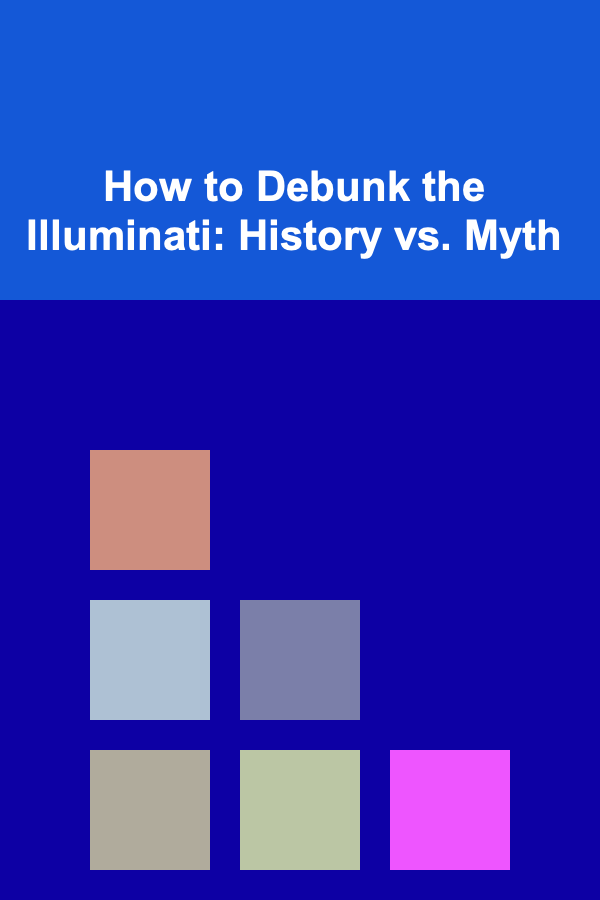
How to Debunk the Illuminati: History vs. Myth
ebook include PDF & Audio bundle (Micro Guide)
$12.99$5.99
Limited Time Offer! Order within the next:

The Illuminati --- a term that conjures up images of shadowy elites pulling the strings behind world events, manipulating politics, and controlling the masses from the shadows. It is a name that has been woven into the fabric of conspiracy theories for centuries, often associated with secret societies, world domination, and clandestine plots. However, understanding the history of the Illuminati and distinguishing it from the myths that have arisen around it is essential for clearing up the fog of mystery surrounding the subject.
In this article, we will take an in-depth look at the origins of the Illuminati, the rise of the myth, and how to separate fact from fiction when it comes to the so-called "secret society" that has become synonymous with conspiracy theories.
The Birth of the Illuminati
The Illuminati, in its historical form, was not a shadowy cabal of world leaders, but rather a small, intellectual group that formed in 1776 in Bavaria, part of the Holy Roman Empire. The group was officially called the Order of the Illuminati, and its stated goals were philosophical in nature. Its members sought to promote Enlightenment ideals such as reason, secularism, and the advancement of knowledge, while opposing religious and political authoritarianism.
The Founding of the Illuminati
The Illuminati was founded by Adam Weishaupt, a professor of law at the University of Ingolstadt. Weishaupt, influenced by the Enlightenment movement, was disillusioned by the authoritarian nature of the church and the state. He wanted to create an organization that would foster critical thinking, rational discourse, and intellectual freedom. To this end, he modeled the Illuminati after the Freemasons, with whom he had been involved, but he envisioned it as a more radical and covert society.
The Illuminati's mission was simple yet ambitious: to work toward the elimination of religious dogma and promote the rights of individuals. The group's structure was hierarchical, with levels of initiation and a strict code of secrecy. Weishaupt and his followers believed that through education and enlightenment, they could change the world and make it a more just and rational place.
The Illuminati's Brief Existence
The Illuminati did not last long as an active organization. Within a decade of its founding, it was suppressed by the Bavarian government. In 1785, the government banned all secret societies, including the Illuminati, and many of its members were arrested. The society's activities were largely disrupted, and its influence was effectively erased from history. The order disbanded, and its members went underground or returned to their everyday lives.
At this point, the Illuminati might have faded into obscurity, but this was not to be the case. Its brief existence, combined with its secretive nature, laid the foundation for a series of conspiracy theories that would persist for centuries.
The Rise of the Illuminati Myth
The Illuminati's real significance lies not in its historical actions but in the mythology that surrounds it. The society's name and legacy were quickly co-opted by conspiracy theorists, who would exaggerate its reach and importance in the years that followed.
Early Myths and Misunderstandings
The first wave of rumors about the Illuminati began shortly after its suppression in Bavaria. A pamphlet titled "Memoires pour servir à l'histoire du Jacobinisme" was published in 1797 by Abbé Barruel, a French priest. In this pamphlet, Barruel argued that the Illuminati was part of a larger, sinister conspiracy to overthrow traditional power structures, including the monarchy, the church, and the state. According to Barruel, the Illuminati had infiltrated various revolutionary movements and sought to bring about a secular, global government. This idea of the Illuminati being a subversive force aligned with the revolutionary changes in Europe took hold in many circles.
As the French Revolution unfolded and radical political movements gained momentum, the notion that secret societies were pulling the strings behind these revolutions gained further traction. The Illuminati was depicted as a covert organization orchestrating upheaval on a global scale. The myths of the Illuminati were now intertwined with real-world events and the revolutionary fervor of the late 18th century.
The Influence of the 19th Century and the "New World Order"
In the 19th century, the myth of the Illuminati continued to evolve. In particular, a conspiracy theory that still holds influence today took root: the idea of a "New World Order" (NWO), a secret cabal of elites controlling global affairs. The Illuminati were now portrayed not as a defunct society, but as a powerful organization still operating in secret, pulling the strings behind governments, banks, corporations, and other influential institutions. This idea was popularized by authors like John Robison, whose book "Proofs of a Conspiracy" (1797) further linked the Illuminati to the rise of Freemasonry and the French Revolution.
Throughout the 19th and early 20th centuries, the Illuminati continued to be invoked as the source of virtually every global conspiracy, from the development of communism to the manipulation of the financial system. The idea of a shadowy group controlling world events from behind the scenes became a fixture in popular culture and political discourse.
The Illuminati in Popular Culture
The 20th century saw the Illuminati myth reach new heights, particularly with the advent of mass media. Books, films, and later, the internet, allowed the Illuminati conspiracy theory to spread far and wide. Authors like Dan Brown, with his best-selling novel The Da Vinci Code (2003), incorporated the Illuminati into mainstream fiction, blending fact and fiction in ways that blurred the lines between history and mythology.
In the modern era, the Illuminati has become a symbol of a broader distrust of power and authority. Conspiracy theorists have adapted the Illuminati myth to fit a range of political and social narratives. From claims that the Illuminati controls the world's financial institutions to accusations that celebrities are part of an Illuminati cabal, the myth has evolved into a catch-all explanation for perceived societal injustices and inequalities.
Debunking the Illuminati Myth
While the Illuminati myth has persisted for centuries, it's important to debunk the notion of a global conspiracy orchestrated by a secret society. The facts don't align with the conspiracy theories surrounding the Illuminati, and a critical examination of the history and evidence reveals the discrepancies.
1. The Illuminati's Short-Lived Existence
The most glaring fact is that the Illuminati, as an actual organization, was extremely short-lived. It existed for only a few years in the late 18th century before it was suppressed by the Bavarian government. The idea that the Illuminati continues to operate secretly in modern times is unsupported by any credible evidence. After the group was disbanded in 1785, it ceased to have any real influence on world events.
2. Lack of Evidence for Global Conspiracy
Despite the widespread claims of Illuminati control, there is no concrete evidence that such a global conspiracy exists. The Illuminati was a small, intellectual society, and there is no proof that it had any significant reach or influence beyond the small circle of its members. Modern conspiracy theories that link the Illuminati to world events rely on speculation, coincidence, and a fundamental misunderstanding of history.
3. The Problem with Confirmation Bias
One of the reasons the Illuminati myth persists is due to confirmation bias, the tendency to search for or interpret information in a way that confirms preexisting beliefs. Conspiracy theorists often point to vague or unrelated events and claim they are the work of the Illuminati. For example, the widespread rumors about famous celebrities being part of the Illuminati are based on nothing more than speculation and misinterpretation of symbols. The Illuminati symbol, the all-seeing eye, is used in a variety of contexts and has historical significance beyond its association with conspiracy theories.
4. The Role of the Internet and Social Media
In the digital age, the spread of conspiracy theories has been turbocharged by the internet and social media. Platforms like YouTube, Twitter, and Reddit allow individuals to share and amplify their ideas, no matter how unfounded. The Illuminati myth has flourished in this environment, with people posting videos, articles, and memes that claim to have "proof" of its existence. However, these claims often lack credible sources and fail to stand up to scrutiny.
5. The Appeal of Conspiracy Theories
The persistence of the Illuminati myth also speaks to a larger psychological and cultural phenomenon: the appeal of conspiracy theories. In a world full of uncertainty, people may be drawn to the idea of a hidden, controlling force behind major events. Conspiracy theories provide a way to make sense of complex issues and offer a sense of control over a chaotic world. The Illuminati myth, with its focus on secretive elites and global manipulation, taps into these fears and anxieties.
Conclusion: Understanding the Real Illuminati
The history of the Illuminati is far less dramatic and sinister than the myth suggests. In its original form, the Illuminati was a philosophical society with the goal of promoting reason and opposing authoritarianism. It lasted only a few years before being disbanded by the Bavarian government, and there is no credible evidence to suggest that it continues to operate today as a global conspiracy.
While the Illuminati myth may have roots in real historical events, it has been distorted and exaggerated over the centuries. The myths surrounding the Illuminati are fueled by confirmation bias, misinformation, and a cultural tendency to believe in hidden forces controlling the world. By examining the history of the Illuminati and separating fact from fiction, we can better understand the role of conspiracy theories in shaping our view of the world.
In the end, the best way to debunk the Illuminati myth is not just to dismiss it but to understand the historical context in which it arose and recognize the factors that have allowed it to persist. The truth is far less exciting than the myth, but it's much more useful in helping us navigate the world of conspiracies and the realities of power and influence.

How to Keep Your Garage Clean Year-Round
Read More
How to Make Your Home's Entryways More Secure
Read More
How to Save Money on Transportation Costs Without Compromising Convenience
Read More
How to Tidy Your Home Quickly When Unexpected Guests Arrive
Read More
How to Use Vacuum-Sealed Bags for Storing Winter Coats
Read More
How To Write for Different Genres: A Deep Dive into Fantasy, Sci-Fi, and Romance
Read MoreOther Products

How to Keep Your Garage Clean Year-Round
Read More
How to Make Your Home's Entryways More Secure
Read More
How to Save Money on Transportation Costs Without Compromising Convenience
Read More
How to Tidy Your Home Quickly When Unexpected Guests Arrive
Read More
How to Use Vacuum-Sealed Bags for Storing Winter Coats
Read More